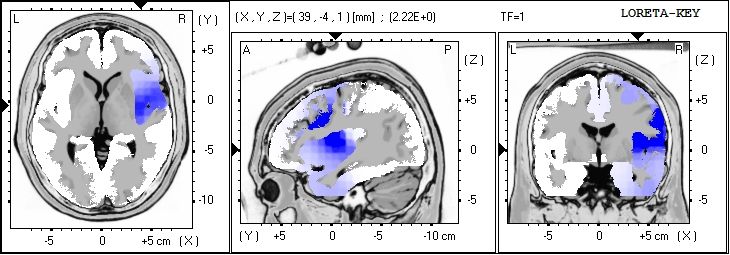LORETA can be done in a few ways… as a source analysis for the entire EEG or segment being analyzed… or after a decomposition into the ICA components… The later will provide a better estimate of generators of the
individual components which are all blended for the overall LORETA, distorting the sources with other sources.
LORETA
Thalamic Involvement in the Generation of the Alpha Rhythms
Alpha… it’s not a simple idling rhythm… let’s look at alpha generators:
The thalamic involvement in the generation of the alpha rhythm is being under-valued when looking at the LORETA images of alpha current source generators. The alpha power may come from the sources that LORETA identifies, but the thalamus is intimately involved in alpha rhythm generation, and this is not part of the LORETA image of the sources.
The polarization within the thalamus sets the base frequency of the alpha, but the cortical rhythm requires a complex multi-layer feedback loop from the thalamus to the cortex, and back to the thalamus. Without the cortex, there is a total disruption of the normal spatio-temporal distribution of the alpha wave’s spike trains within the thalamus, and cortical damage often disturbs coherence due to this mechanism.
The thalamus distributes the alpha posteriorly via specific sensory relays, which have a simple return circuit. Like the white matter relay from the lateral geniculate of the thalamus to the occipital lobe’s primary visual areas, and directly back. This thalamo-cortical-thalamic loop is relatively faster than the loop seen frontally. The frontal return circuitry is not simple, but the descending routes are complex and somewhat circuitous, taking more time, and thus it is common for the frontal lobe’s alpha to be at the slower end of the individual’s alpha frequency range. The frontal lobe has a return path through the striatum.
A discussion on LORETA software use and licensing.
April 30, 2009
Leslie Sherlin, PhD
There recently has been some discussion regarding the use of low resolution brain electromagnetic tomography or LORETA, sLORETA and eLORETA. I felt compelled to make a few comments regarding this since there may be some confusion of how LORETA works and the usage of LORETA as an inverse solution specifically the licensing agreements of the KEY Institute for Brain-Mind Research at the University Hospital of Psychiatry, Zurich.
My intention is to very briefly explain the license agreement so that the end user can be informed. I’ll do so in an informal way by telling the story of the implementation of these methods from my perspective. For a more formal description of the use of LORETA families and some examples you can see a recently written chapter 4 by myself (Sherlin, 2009) in the latest edition of the book Introduction to Quantitative EEG and Neurofeedback edited Budzynski, Budzynski, Evans & Arbarbanel.
In 2000 I had the great privilege to visit with Roberto Pascual-Marqui PhD, the developer of the LORETA family, with my colleague and fellow student Marco Congedo. At this time the LORETA-Key software (Pascual-Marqui, 1994, 1999), had not been widely distributed and utilized in the United States. Marco had significant interest in using LORETA for visualizing brain activity and for exploring newer methods for neurofeedback and had many questions for Roberto. So upon the invitation of Roberto, Marco found funding to travel to Zurich and learn the details from the creator and I happen to be standing in the right spot at the right time. Roberto Pascual-Marqui trained us extensively on how to use his software, named LORETA-Key, which had been already released as free academic software. The LORETA-Key software is a collection of independent modules that the user must run in sequence in order to get from raw EEG to LORETA images.

